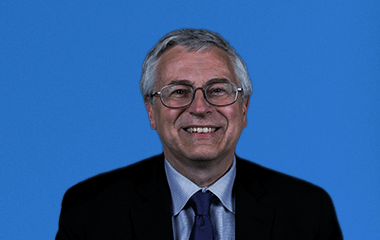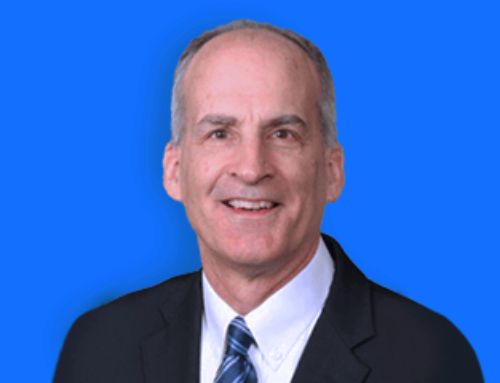James A. Rowley, MD, became the president of the American Academy of Sleep Medicine board of directors on Monday, June 5, 2023, during the AASM annual membership meeting, which took place in Indianapolis as part of the SLEEP 2023 annual meeting of the Associated Professional Sleep Societies.
This is an excerpt of the remarks that he presented during the membership meeting.
Remarks by Dr. James Rowley
Thank you for the incredible honor of being elected president of the American Academy of Sleep Medicine. I stand here humbled and promise to lead the Academy this coming year with honor, integrity, and with the goal of looking toward our future.
If there is one constant in my career in sleep medicine, it’s actually been that of change in the field. I started in this field in 1993 when I was a pulmonary/critical care fellow at Johns Hopkins. We were using PSG machines that had pens and ink, and we could tell when there was a problem because of changes in the ambient noise! Everyone got a full-night PSG, and if you were sleepy, you pretty much got an MSLT as well, even if narcolepsy wasn’t in the differential. We pretty much had only two options for OSA treatment: CPAP and surgery. Pharmacological management of other disorders was narrow: benzodiazepines for insomnia, Sinemet for RLS, and amphetamines for narcolepsy. We were also not a recognized field of medicine.
Today, the field of sleep medicine is vastly different. For one, we are a recognized field of medicine, one of the few truly multi-and-interdisciplinary fields in medicine. Home sleep apnea testing is now routine, and the number of devices to provide that testing continues to explode.
Treatment options have expanded: Oral appliances are now an option for our mild OSA patients, and hypoglossal nerve stimulation is an option for our less obese patients. And I cannot even state the number of new medications we have for treatment of insomnia, RLS, and narcolepsy, many of which are based upon the amazing discoveries about the mechanisms of sleep and pathophysiology by our sleep research colleagues.
Another big change is the growth of the Academy. Nearing its 50th anniversary (in 2025), the Academy has always been important to the field. But that importance has only grown as the number of accredited centers has increased; as the number of evidence-based guidelines has risen (along with the complexity of providing GRADE-based reviews); as the need for up-to-date education has exploded; and finally as we’ve recognized the growing need to continue workforce development for the field, including the inclusion of advanced practice providers.
But change is not going to stop anytime soon, and in fact, it will likely accelerate. As everyone knows, artificial intelligence is all the rage in the lay news these days. And AI is certainly going to increasingly change the practice of medicine in general and sleep medicine specifically. It’s already becoming an important component for the scoring of PSGs. But how else will it change the field? Will AI allow us to better select patients for the appropriate test (or possibly even indicate those who do not need testing)? Will AI allow us to better select the appropriate management for a patient, improving initial adherence and outcomes?
And increasingly, emerging technology is putting patients in charge of their own health, primarily with wearables (several of which are available to detect OSA). While I have not personally had too many patients show up with a download from their smartwatch, I know for many of my colleagues, this is happening more and more. How will these devices change how patients recognize they have a disorder and arrive for an evaluation? Can we use these devices to better engage patients in their own care as they can monitor their sleep at home?
A major question for the field is how will AI and wearables be incorporated into our daily practice? Will they be incorporated because industry creates a device and then designs their own pathways? Or will sleep researchers study them with a systematic approach to see if they truly change outcomes? How can the Academy stay on top of these developments and encourage research into pathways that incorporate AI, wearables, and whatever new tech device the FDA approves in the coming years? And how can we then educate our members to optimize their practice and patient care?
Four years ago, under my predecessor Kelly Carden, the Academy board participated in a strategic planning process that resulted in the present strategic plan. This plan has been our “north star” for the last several years as the board has focused increasingly on strategy. Every decision we make, we try to ask, “Does it fit into our strategic plan?” Using this plan, we have increased our advocacy in Washington, created patient and public-facing awareness campaigns, developed new guidelines, created the AIRE program for innovative fellowship training, developed new educational programs for our sleep team members, and created resources to help members understand technology innovations and disruptions in the sleep field.
However, as the board continued to look strategically at the field and the role of the Academy, we decided it was time to revisit the plan. Are our mission and vision statements and goals still appropriate? More importantly, are the objectives within our goals taking us in the right direction? Should there be new goals or just new objectives within the present goals? How can we be nimble in a changing environment? How can we best direct our staff to advance the goals we care about?
So, one of the priorities of my presidency will be to guide the board and organization through a strategic planning process to update and strengthen our current plan. We have already started having meetings with a task force and plan to meet in person in September for a planning retreat. In the end, I hope that we will better position the Academy to recognize changes in the field and to be proactive, rather than reactive, in meeting the challenges that are sure to arise.
In closing, I thank you again for providing me the honor of being president of the Academy.





